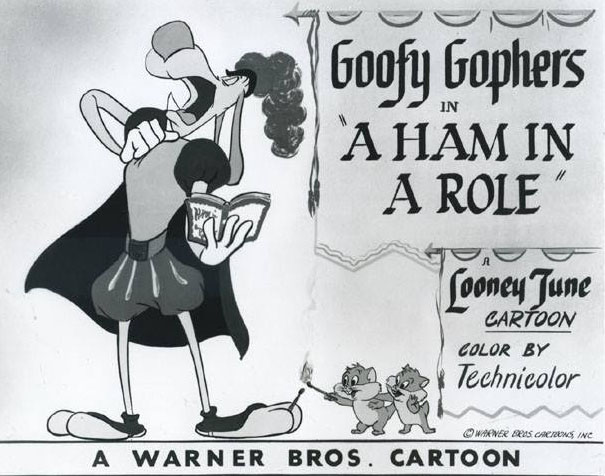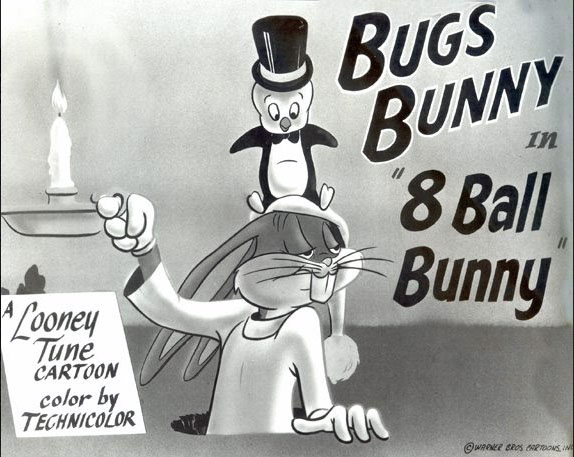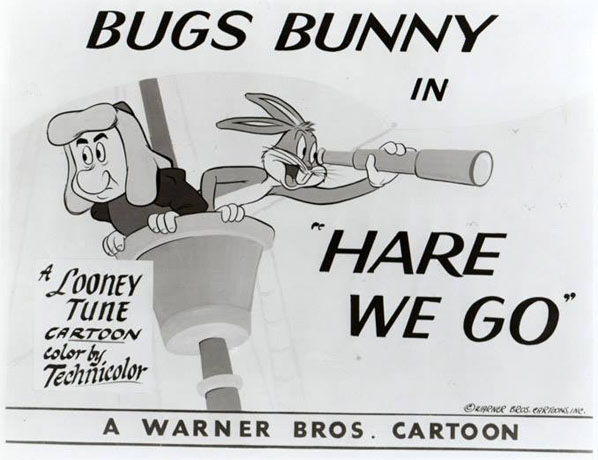By the early 1950’s the need to plug Warner songs wasn’t as drastic as in the past. Carl Stalling was free to use “ballads, sings and snatches” in a more “natural” manner, after the fashion of their uses in contemporary features. Popular melodies, past and present, would appear as leitmotiven, used more as underscore than as cudgels to the audience or to push sales of sheet music in the lobby.
For Scent-imental Reasons (11/12/49) – Pepe Le Pew in a parfumerie, whose owner, upon getting a whiff of Pepe, immediately runs for the nearest gendarme (who is of no help at all). Send in the weapon of last resort – a femme pussy cat to chase the skunk away. The inevitable white stripe is acquired on her back, and the romantic chase is on – with role reversal when Pepe falls into a pot of blue paint, causing cat not to recognize him, and fall under the spell of l’amour herself. Songs: “The Latin Quarter” reappears in a new fractured French lyric; “Time Waits For No One” from the Warner feature Shine on Harvest Moon (1944), on the other hand, appears with what sounds like a genuine French translation. Also used for the first time is “Alouette”, a song associated with French Canada. The title refers to a lark, and it is something of the French equivalent of “Schnitzelbank”. An early recording of the piece was recorded by Stanley Holloway on HMV. It has also appeared in countless children’s versions.

A Ham In a Role (12/12/49) – A dog, weary of pie-in-the-face slapstick, decides to retire from the screen to study the works of the immortal Bard. He finds his lawn full of gopher holes, and the two oh-so-polite Goofy Gophers sleeping inside his book of Shakespeare. Every attempt to rid himself of these pests is accompanied by a Shakespearian quote, delivered in highly romantic style. Eventually, the dog is content to return to a life of custard pies, strumming his lips for the iris out. “Goblins In the Steeple” appears for the first time, accompanting one of the gophers dressing up as a skeleton, recorded by the Milt Herth Trio on Decca in 1938. Stalling would find subsequent uses for the piece in Halloween settings for Witch Hazel and the like. Recurring numbers include “Merrily We Roll Along”, tied in with the dog’s appearances at the Warner studio. “Love Me and the World Is Mine” also appears over the opening title, and “In My Merry Oldsmobile”, “California, Here I Come”, “By a Waterfall”, and “You Ought To Be in Pictures”. Also here is a little Sammmy Kahn, Jules Style tune from Two Guys From Texas (1948) called “There’s Music In The Land”:
Mutiny on the Bunny (6/24/50) – Shanghai Sam shanghais Bugs to be his “crew”, after his previous one-man slave goes A.W.O.L. Abundant gags involving cannons and Sam’s ship repeatedly sinking to the bottom and having to be rebuilt. Sam winds up in a launch with Bugs, and is forced to serve as involuntary rowing tour guide, with Bugs prodding him to step on it to make Rio De Jan-er-i-o. The star newcomer among songs is “Put ‘Em in a Box, Tie ‘Em With a Ribbon”, introduced by Doris Day in the Warner feature, Romance on the High Seas, and recorded by her commercially for Columbia. Because of another Petrillo recording ban, Danny Kaye and the Andrews Sisters’ collaborative effort at the number on Decca had to be recorded with harmonica accompaniment, which for reasons known only to the unions were not classified at the time as musical instruments. (Tell that to Larry Adler!) Frankie Laine performed it on Mercury, and the Nat “King” Cole Trio on Capitol. Also included is “Blow the Man Down”, a traditional sea chanty, most memorably recorded for animation buffs by Billy Costello (the original Popeye) on Melotone and the dime store labels in the 1930’s. Recurring numbers include “Aloha Oe”. “A Life On the Ocean Waves”, and “Columbia, the Gem of the Ocean”.
All A-bir–r-rd (6/24/50) – Tweety is taking a solo train ride, without “mommy” (voiced by Bea Bernaderet), along with fellow baggage car passengers Sylvester and the as yet unnamed Hector the bulldog. Destination Pasdadena, with one stop along the way at Gower Gulch. Lots of battering and bruises for Sylvester, including his cage sliding along the baggage car floor on uphill and downhill grades, placing Sylvester’s face smack in the path of Hector’s fist. Tunnels and a conductor also provide Sylvester with lumps. Sylvester finally impersonates Tweety’s owner, but gets Hector in the bird cage instead. Primary new number is good oldie – “On the 5:15″, appearing over the opening shots. It was written in 1915, and recorded by Billy Murray and the American Quartet on Victor (below), Collins and Harlan on Columbia, and Pete Murray on Edison.
As an additional special treat (and a bit of a self-promotion), I include this link to a live performance of the number in duet between myself and Animation Trails columnist Charles Gardner, performed in reprise of a previous concert appearance by us at the Fullerton Ragfest. (Pardon our need of a shave during this party performance.) Enjoy!

8-Ball Bunny (7/17/50) – An ice show is closing om Brooklyn, and a penguin is left behind. Bugs Bunny connsults his reference work, and finds penguins are from the South Pole. His reaction: “Ooh! I’m. DYYYYY-I NG!” A globetrotting adventure ensues, that frequently finds them on the menu at various locations. A running gag involves a Humphrey Bogart caricatire, quoting a panhandling line from “The Treasure of the Sierra Madre”. When Bugs and his travelling companion finally reach the pole, Bugs discovers that the penguin is actually the only Hoboken-born penguin un captivity. Bugs “dies” again, and the running gag with Bogie wraps up with Bugs giving him “the bird” as a handout. New musical entry for this episode is “Kiss Me Sweet, Kiss Me Simple”, recorded by Dinah Shore on Columbia, Kitty Kallen with Mitch Miller on Mercury (below), Sammy Kaye on RCA Victor, and Nellie Luchter on Capitol. “Don’t Sweetheart Me” also appears over the credits. “Brahms’ Lullaby” and “The Curse of an Aching Heart”, make reappearances, and an original calypso is sung by Bugs upon reaching the isle of Martinique.
Rabbit of Seville (12/16/50) – The usual gun chase between Elmer and Bugs, transplanted to the operatic stage, with a plethora of barber gags in a production of Rossini’s opera. The film marks Warner’s first use of the Rossini overture, rather than the familiar “Largo al Factotum”, as score for the entire cartoon. The overture was recorded in 1925 by Rudolph Ganz on Victor (blue label). Later Victor versions included Arturo Toscanini and the Philharmonic Symphony Orchestra of New York, and Arthur Fiedler and the Boston Pops. A ”vocal” version was performed by the Comedian Harmonists on HMV. Many of Rossini’s operas are in fact today better known for their overtures than for their content – “William Tell” being another such instance, with the opera practically never staged today. While Bugs sings some short passages, he has only one line of spoken dialogue, for the final iris out: “Eh, next?”

Hare We Go (1/6/51) – Christopher Columbus tries to set sail from Spain to prove the world is round like a baseball. Bugs Bunny signs aboard as mascot, and also winds up as cook. The journey is so long the crew may have to cook their mascot! They reach the New World only to find it more like Coney Island, and though Bugs is the first to land, he lets Chris take the credit: “Why should I have them change the history books?” Songs include first use of “Santa Lucia” over the credits, a traditional Neapolitan song, recorded by artists as diverse as Enrico Caruso and Elvis Presley (both for the same Victor label!). The number is more well remembered in use by Warner as a vocal vehicle for Tweety Pie in “A Pizza Tweetie-Pie”. “Let That Be a Lesson To You” returns for its verse about Christopher Columbus, as well as “Frat”.
Rabbit Every Monday (2/10/51) – Title is inspired by a feature from the 1940’s, entit;ed “Chicken Every Sunday”. A personality plot for Bugs and Yosemite Sam, mostly revolving around the efforts of Yosemite to get Bugs into the oven. Bugs turns the tables, playing like there’s a wild celebration going on inside the stove, with the girls asking for Sam. When Sam takes Bugs’ place in the oven, Bugs has second thoughts about his “joke”, and tries to let Sam loose – only to discover there really is a wild soiree going on inside. Bugs joins Sam – “I don’t ask questions. I just have fun”. Songs: “It’s Magic”, the breakthrough hit that launched Doris Day’s movie career in Romance on the High Seas (below). Doris would record the piece for Columbia, but truly outdid herself several years later with a 3:45 long album remake for her “Greatest Hits” album with Percy Faith and his orchestra, that will melt your heart away. Other versions included Dick Haymes on Decca, Tony Martin on RCA Victor. Sarah Vaughan on Musicraft, Gordon Macrae on Capitol. Vic Damone on Mercury, the Buddy Kaye Quintet on MGM, and a superb two-tempo sweet and swinging version by Keely Smith and Nelson Riddle on Capitol. Returns for “Cuddle Up a Little Closer”, and “I’m Forever Blowing Bubbles.
Next Time: More tuneful treasures from 1951-52.


 James Parten has overcome a congenital visual disability to be acknowledged as an expert on the early history of recorded sound. He has a Broadcasting Certificate (Radio Option) from Los Angeles Valley College, class of 1999. He has also been a fan of animated cartoons since childhood.
James Parten has overcome a congenital visual disability to be acknowledged as an expert on the early history of recorded sound. He has a Broadcasting Certificate (Radio Option) from Los Angeles Valley College, class of 1999. He has also been a fan of animated cartoons since childhood.












































“Alouette, gentle alouette! Alouette, gentle boomerang!” — Beaver Cleaver
The American Federation of Musicians classified the harmonica as a toy (for the obvious reason that they were sold in toy stores) until 1947, when the Harmonicats’ recording of “Peg o’ My Heart” became the best-selling record of the year. This wouldn’t have made any difference to Larry Adler, who was based mainly in London from the mid-thirties and settled there permanently after being blacklisted during the McCarthy era.
Bugs Bunny’s calypso song in “8-Ball Bunny” actually relates to the Bogie cameo in that cartoon. Humphrey Bogart and Lauren Bacall starred in a short-lived radio program about treasure hunters in the Caribbean called “Bold Venture”, in which calypso songs commenting on the plot were used as interludes. I always thought Bogart’s appearance in that cartoon was totally random and absurd, but audiences at the time would have understood the connection.
Rossini originally composed his overture to “The Barber of Seville” (1816) for an earlier opera, “Aureliano in Palmira” (1813) and subsequently used it again for “Elizabeth, Queen of England” (1815). During this period Rossini composed at least two, and sometimes as many as four, operas in a year; he was often busy composing right up until opening night, and therefore didn’t always have time to write an original overture. Since “Barber” opened in Rome, while “Aureliano” had premiered in Milan and “Elizabeth” in Naples, he must have figured he could get away with it, and he did. Curiously, both “Aureliano” and “Elizabeth” are dramatic operas; nowadays, given the overture’s long association with Bugs Bunny and Woody Woodpecker, it’s hard to imagine that music preceding anything but a wild comedy. Unlike “William Tell”, “Barber” remains a staple of the operatic repertoire to this day.
That’s Oscar Levant at the piano in that clip from “Romance on the High Seas”. At that time he was a bigger star than Doris Day — but not for long!
I think you and Charles should do a duet on each instalment of “Needle Drop Notes”. Do you guys know “That Certain Party”?
Considering Murray was a regular voice in the early years of the Fleischer Studio’s sound cartoons, I’m surprised they never used “On the 5:15” as a basis for one of their cartoons, since it sounds like it came directly from a Fleischer soundtrack (you’d assume the studio would have had a field day doing gags about drunk suburban train commuters and angry, vengeful wives).
“Hare We Go” also features “Don’t Give Up the Ship” by Harry Warren over the title cards: https://www.youtube.com/watch?v=y4DYywKeKPI
“8 Ball Bunny” has “All Aboard for Dixieland” when Bugs is at the La Bouche Cafe: https://www.youtube.com/watch?v=1Ec4Rvm8PQw